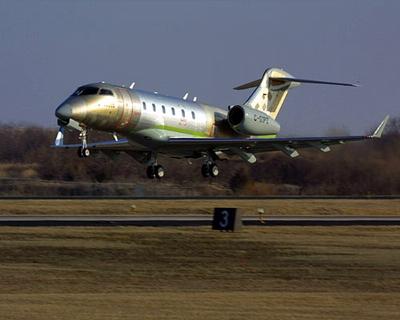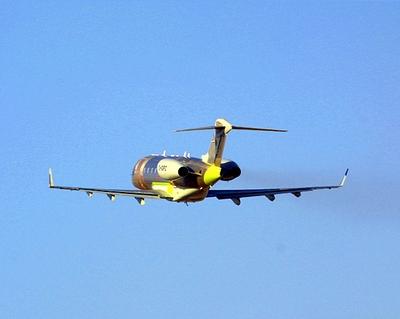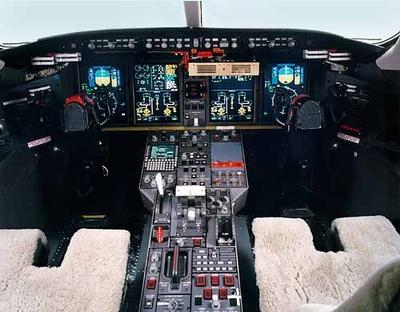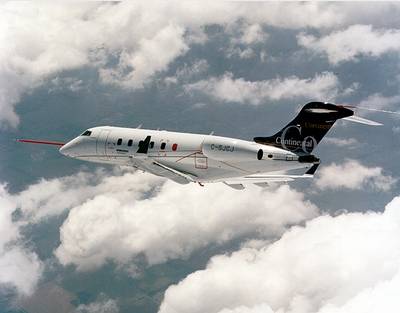New Certs Touted At Paris Air Show
 Bombardier Aerospace announced Sunday that the
all-new Bombardier Challenger 300(i) business jet was awarded full
type certification by the FAA on June 4, 2003 - just five days
after earning Transport Canada type approval on May 30.
Bombardier Aerospace announced Sunday that the
all-new Bombardier Challenger 300(i) business jet was awarded full
type certification by the FAA on June 4, 2003 - just five days
after earning Transport Canada type approval on May 30.
"Obtaining type certifications from both these regulatory
authorities within just days of each other is unprecedented in
corporate aviation history," noted Peter Edwards, president,
Bombardier Business Aircraft. "This is powerful testimony to the
outstanding performance and features of the Bombardier Challenger
300 and follows the successful completion of the most stringent and
comprehensive of certification programs. The world's first true
super midsize business jet is now cleared for takeoff."
 Bombardier executives made the Transport Canada
and FAA certification announcement at the biennial Paris Air Show,
the same location where the Bombardier Challenger 300 was launched,
just four years earlier.
Bombardier executives made the Transport Canada
and FAA certification announcement at the biennial Paris Air Show,
the same location where the Bombardier Challenger 300 was launched,
just four years earlier.
With a freshly painted Bombardier Challenger 300 aircraft as a
striking backdrop, and joined by Bombardier Aerospace president and
chief operating officer, Pierre Beaudoin, and Bombardier Aerospace
executive vice-president of engineering and product development,
John Holding, Mr. Edwards reminded an audience of journalists,
customers, industry officials and special guests that "this paves
the way to begin delivering completed Challenger 300 jets into
service later this year."

Edwards was gleeful at the announcement. "Soon, air traffic
controllers worldwide will start seeing another Challenger business
jet on runways, one that shares the same attributes as the very
successful widebody Bombardier Challenger 604(i) aircraft - rugged
reliability, a large and versatile cabin, and superior value. The
Challenger 300 is already setting the new standard in its class,
establishing two NAA (National Aeronautic Association) - sanctioned
world records in the past week. A test aircraft with less than 300
flight hours set new "Speed over a Recognized Course" marks from
Boston to Le Bourget on Thursday, flying at 583 miles per hour and,
last Tuesday, just five days ago, by transporting eight passengers
non-stop at Mach .80 from Miami to Seattle. This is the level of
performance customers and users can routinely expect and rely
on."

The Bombardier Challenger 300 features a top speed of Mach 0.82
(541 mph; 870 km/h), a maximum non-stop range of 3,100 nautical
miles (5,741 km) and a maximum takeoff weight of 38,500 pounds
(17,463 kg). Total cabin volume is 860 cubic feet (24.35 m3) and it
offers operating costs equivalent to or better than current midsize
jets.
Performance Guarantees Achieved
Transport Canada and the FAA granted Challenger 300 their type
certifications following flight and ground testing programs
conducted in full cooperation with the European Joint Aviation
Authorities (JAA). The program, which began following first flight
in August 2001, involved five flight test aircraft plus two
full-sized static test articles, one for static testing and one for
damage tolerance and fatigue testing. Type approval by JAA to
European JAR Part 25 Change 15, including OP 96/1, is expected
shortly.
Designed to deliver best-of-class value, the Bombardier
Challenger 300 - formerly known as the Bombardier Continental -
provides a cost-effective step-up for current light jet operators
as well as for operators constrained by their current midsize
aircraft.

Powered by two new Honeywell AS907 high bypass ratio turbofan
engines delivering 6,501 pounds (28.9 kN) of thrust, the Bombardier
Challenger 300 can cross the US within five hours. A 4,950-foot
(1,509-m) takeoff balanced field distance and an actual landing
distance of 2,600 feet (792 m) give it exceptional full range and
field performance capability.
A quick time-to-climb capability also enables the airplane to
rise rapidly above both weather and traffic. The initial cruise
altitude is 41,000 feet (12,497 m) at MTOW, ISA +10 degrees
Celsius, with a maximum ceiling of 45,000 feet (13,716 m) where
traffic density is about 19 times lower than at 37,000 feet (11,278
m).

With a 146-square-foot (13.56-sq m) total floor area, the
standard interior floor plan features double-club seating with
generous proportions for passenger comfort. This layout
incorporates an ergonomic seated environment with reclining seats
and easy-access personal service panels while power outlets,
telephone handsets and retractable worktables offer an efficient
and productive workplace.
Passenger comfort is enhanced by a flat floor throughout the
cabin as well as tracking/swivelling seats. Plus, the absence of a
secondary pressure bulkhead provides greater flexibility in
optimizing the cabin, lavatory and baggage spaces. The baggage
compartment measures 106 cubic feet (3.0 cu. m), and is accessible
in flight.
 ANN's Daily Aero-Term (12.14.25): Local Airport Advisory (LAA)
ANN's Daily Aero-Term (12.14.25): Local Airport Advisory (LAA) Airborne 12.08.25: Samaritans Purse Hijack, FAA Med Relief, China Rocket Fail
Airborne 12.08.25: Samaritans Purse Hijack, FAA Med Relief, China Rocket Fail ANN's Daily Aero-Linx (12.15.25)
ANN's Daily Aero-Linx (12.15.25) Airborne 12.10.25: New Gulfstream, ATC Integrator, Outrageous FFZ User Fees
Airborne 12.10.25: New Gulfstream, ATC Integrator, Outrageous FFZ User Fees Airborne-NextGen 12.09.25: Amazon Crash, China Rocket Accident, UAV Black Hawk
Airborne-NextGen 12.09.25: Amazon Crash, China Rocket Accident, UAV Black Hawk








